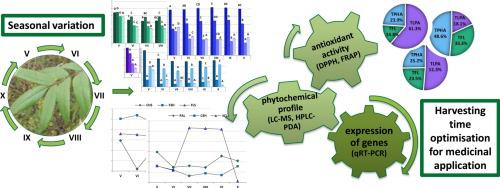Industrial Crops and Products ( IF 5.6 ) Pub Date : 2020-08-19 , DOI: 10.1016/j.indcrop.2020.112858 Magdalena Rutkowska , Ewa Balcerczak , Rafał Świechowski , Monika Dubicka , Monika A. Olszewska

|
Sorbus domestica L. leaves are a phenylpropanoid-rich herbal medicine with antioxidant and anti-inflammatory activity. Here, to optimise harvesting time of the leaves for medicinal application, seasonal variability in the expression of genes encoding enzymes involved in phenylpropanoid biosynthesis (qRT-PCR, quantitative real time polymerase chain reaction) and its relationship with changes in the phytochemical profile (UHPLC-PDA-ESI-MS3, HPLC-PDA-fingerprint, spectrophotometric methods) and antioxidant properties (2,2-diphenyl-1-picrylhydrazyl scavenging and ferric reducing antioxidant power) was evaluated during foliar development. Significant quantitative differences in polyphenolic composition were revealed between spring leaves (predominance of phenylpropanoid acids and flavonoids) and those harvested during the rest of the growing season (predominance of proanthocyanidins, major active components of S. domestica), while their qualitative composition was stable. A set of 40 compounds were detected in the samples by LC–MS/MS including 38 phenylpropanoids. The total phenylpropanoid level (HPLC) in dried leaves dropped from 25.7 mg/g in May to 20.7 mg/g in October but proanthocyanidins and the antioxidant capacity increased simultaneously up to 12.7 mg/g and 49.7 mmol Trolox equivalents/100 g, respectively. Based on the correlation between gene expression and total phenolics and proanthocyanidins (r > 0.825, p < 0.05), phenylalanine ammonia lyase (PAL) and 4-coumaroyl:CoA ligase (4CL) appeared to be core regulators of the phenolic profile among analysed genes (PAL; 4CL; C4H, cinnamate 4-hydroxylase; CHS, chalcone synthase; F3H, flavanone 3-hydroxylase; FLS, flavonols synthase). Due to the synergy of individual components, variability in activity parameters was relatively moderate. Considering the phenylpropanoid levels and antioxidant capacity, the late summer and autumn months (August-October) might be the most advantageous time for harvesting leaf material of optimal quality.
中文翻译:

山梨叶片中苯丙烷生物合成和体外抗氧化活性的季节性变化:药用的收获时间优化
or(Sorbus domestica L.)叶子是一种富含苯丙烷的草药,具有抗氧化剂和抗炎活性。在这里,为了优化用于医学用途的叶片的收割时间,编码参与苯丙烷生物合成的酶(qRT-PCR,定量实时聚合酶链反应)的基因的表达及其与植物化学特征变化之间的关系(UHPLC- PDA-ESI-MS 3,HPLC-PDA指纹图谱,分光光度法)和抗氧化剂特性(2,2-二苯基-1-吡咯肼基清除和三价铁还原抗氧化剂能力)进行了评估。在春季叶(苯丙酸和黄酮类化合物占优势)和生长季其余时间收获的叶(主要是原花青霉的主要活性成分)之间发现,多酚组成存在明显的数量差异。),而其定性成分稳定。通过LC-MS / MS在样品中检测出40种化合物,其中包括38种苯基丙烷。干燥叶片中的总苯丙烷含量(HPLC)从5月的25.7 mg / g下降至10月的20.7 mg / g,但原花青素和抗氧化剂的容量同时增加,分别达到12.7 mg / g和49.7 mmol Trolox当量/ 100 g。基于基因表达与总酚和原花色素之间的相关性(r > 0.825,p <0.05),苯丙氨酸氨裂合酶(PAL)和4-香豆酰基:CoA连接酶(4CL)似乎是所分析基因(PAL; 4CL; C4H,肉桂酸4-羟化酶; CHS,查尔酮合酶; F3H)中酚谱的核心调控因子(黄烷酮3-羟化酶; FLS,黄酮醇合酶)。由于各个成分的协同作用,活动参数的变化相对较小。考虑到苯丙烷的含量和抗氧化能力,夏末和秋季(八月至十月)可能是收获最佳品质叶片材料的最有利时机。











































 京公网安备 11010802027423号
京公网安备 11010802027423号